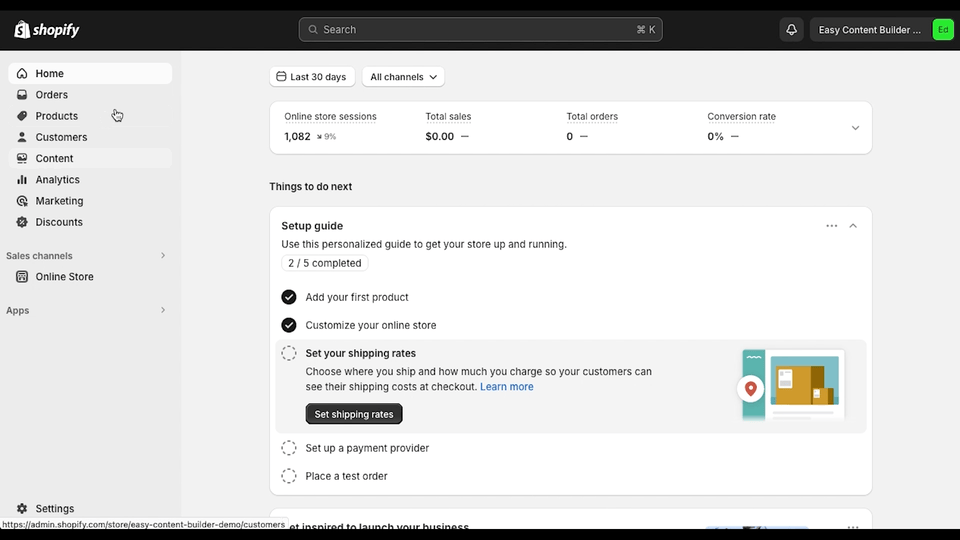Add metaobject entries: Difference between revisions
From Posstack.com Documentations
No edit summary |
|||
| (8 intermediate revisions by the same user not shown) | |||
| Line 1: | Line 1: | ||
{{DISPLAYTITLE:Add Metaobject entries}} | {{DISPLAYTITLE:Add Metaobject entries}} | ||
{{Note|This step guides you how to use Metaobject to add custom data for the product, store page or blog post.<br/> | |||
Then you can create Metaobject template to present this custom data by the guide in the next step. |inline}} | |||
==Add Metaobject entries== | ==Add Metaobject entries== | ||
| Line 12: | Line 13: | ||
:For each metaobject you want to display on your theme, click on the corresponding metafield > click '''Add entry''' and fill out the fields for your metaobject entry. | :For each metaobject you want to display on your theme, click on the corresponding metafield > click '''Add entry''' and fill out the fields for your metaobject entry. | ||
{{Note|You can also select existing entries from the listif you want reuse the same content across multiple pages.<br/> E.g: If you added information about "author A" for one book, then you can reuse this information for other books that written by this author.<br/> In this case, you only need to add new entry for the metaobject ECB Rich Text to store information of the book that is being edited, and select entry of Author A from existing entries of metaobject ECB Author |inline}} | |||
====For Metafield referenced to a Single Metaobject entry==== | ====For Metafield referenced to a Single Metaobject entry==== | ||
| Line 37: | Line 39: | ||
==Next Steps== | ==Next Steps== | ||
====Create Metaobject Templates==== | |||
After adding custom data for products. You need to create Metaobject template to display these data on front store. | |||
Learn [[Create_metaobject_template|how to create metaobject templates here]]. | |||
Revision as of 04:45, 6 June 2024
This step guides you how to use Metaobject to add custom data for the product, store page or blog post.
Then you can create Metaobject template to present this custom data by the guide in the next step.
Then you can create Metaobject template to present this custom data by the guide in the next step.
Add Metaobject entries
NOTE: This guide provides instructions for adding Metaobject entries for products. The steps are the same for articles and store pages.
Steps:
- Go to your Shopify admin > Products.
- Find and select the product to which you want to add metaobject-backed sections.
- On the Edit Product screen, scroll down to the Metafields section, you will see a list of new metafields (depending on which metaobject definitions you created in Step 1).
- For each metaobject you want to display on your theme, click on the corresponding metafield > click Add entry and fill out the fields for your metaobject entry.
You can also select existing entries from the listif you want reuse the same content across multiple pages.
E.g: If you added information about "author A" for one book, then you can reuse this information for other books that written by this author.
In this case, you only need to add new entry for the metaobject ECB Rich Text to store information of the book that is being edited, and select entry of Author A from existing entries of metaobject ECB Author
E.g: If you added information about "author A" for one book, then you can reuse this information for other books that written by this author.
In this case, you only need to add new entry for the metaobject ECB Rich Text to store information of the book that is being edited, and select entry of Author A from existing entries of metaobject ECB Author
For Metafield referenced to a Single Metaobject entry
- The list of metafields in this group:
- ECB Rich Text
- ECB Media
- ECB Author
- ECB Accordions.
- ECB Tabs
- For Metafields in this group, you only need to add one metaobject entry for each metafield, like in this video:
For Metafields referenced to Multiple Metaobject entries
- The list of Metafields in this group:
- Icons With Text.
- Note: You can add one or more Metaobject entries for each Metafield, and each entry will be displayed as an item in the linked block. For example, you can add multiple items for the Icons With Text block.
For Metafields in this group, you can add multiple metaobject entries, like in this video:
Next Steps
Create Metaobject Templates
After adding custom data for products. You need to create Metaobject template to display these data on front store.


